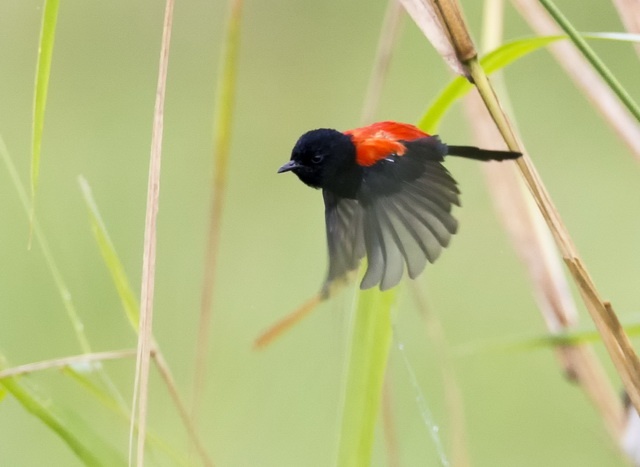Only old and bright males seek extra-pair mates
Red-backed fairy-wren males know how to behave to maximize their fitness, Denélle Dowling and Michael Dowling show. A male that has a bright breeding plumage invests in courting extra-pair females, whereas a man with a dull appearance invests in mate guarding.
Like most songbirds, red-backed fairy-wrens, which live in Australia, form socially monogamous pairs, and a couple may stay together for years. This doesn’t mean that the birds are faithful, however: roughly half of the young is not sired by the social father. Adultery is the rule.
In the breeding season, a male may adopt one of two alternative strategies. He can either invest in seeking extra-pair copulations to gain extra-pair offspring in addition to within-pair offspring, or he can stay on his own territory to defend it the against other couples together with his mate, to help provision the young – and to keep other males away from his mate to minimize the risk of being cuckolded.
Preference
What strategy is the best strategy? Jenélle Dowling and Michael Webster argued that the answer differs among males. It just depends on how attractive a male is to other females.
And the males differ greatly in attractiveness. Some have a bright, black and red plumage, while others have a dull, brownish plumage, much like a female. Almost all males aged more than two years are brightly coloured, among young males about half is bright. It was already known that females prefer bright males. Also, they prefer old males, as their age indicates that they are of good quality.
So, old black-red males are the most attractive ones. The best strategy for them will be to foray to neighbouring territories and court other females, Dowling and Webster assumed, as they stand a real chance to succeed. For dull males, on the contrary, it will be better to stay with their partner, as other females will be reluctant to copulate with them. Moreover, a dull male runs a high risk of being cuckolded by his social partner whenever an attractive male approaches her when she is alone. Young black-red males can try to gain extra-pair copulations, but they will be less likely to succeed than old males.
The researchers set up an investigation to find out whether red-backed fairy-wren males act in their best interests. And it turns out that they do. Old black-red males frequently leave to search for extra-pair females, while brown males mostly remain on their territory. Young black-red males adopt an intermediate strategy.
Cuckolded
DNA analyses of parents and young birds revealed that black-red males (young and old) sire more extra-pair young, as expected, but less within-pair young than dull males; apparently, bright males are cuckolded more often.
The latter result is not undisputed. In other studies, including that of Jordan Karubian, brown males were found to have less young than black-red males and to be cuckolded more frequently, even though they guarded their mate closely. But still, the best strategy for them is to stay on their territory. Otherwise, they will probably be cuckolded even more.
Willy van Strien
Photo: Red-backed fairy-wren, bright male. Jim Bendon (Wikimedia Commons, Creative Commons CC BY-SA 2.0)
Sources:
Dowling, J. & M.S. Webster, 2017. Working with what you’ve got: unattractive males show greater mateguarding effort in a duetting songbird. Biology Letters 13: 20160682. Doi: 10.1098/rsbl.2016.0682
Karubian, J., 2002. Costs and benefits of variable breeding plumage in the red-backed fairy-wren. Evolution, 56: 1673-1682. Doi: 10.1111/j.0014-3820.2002.tb01479.x
